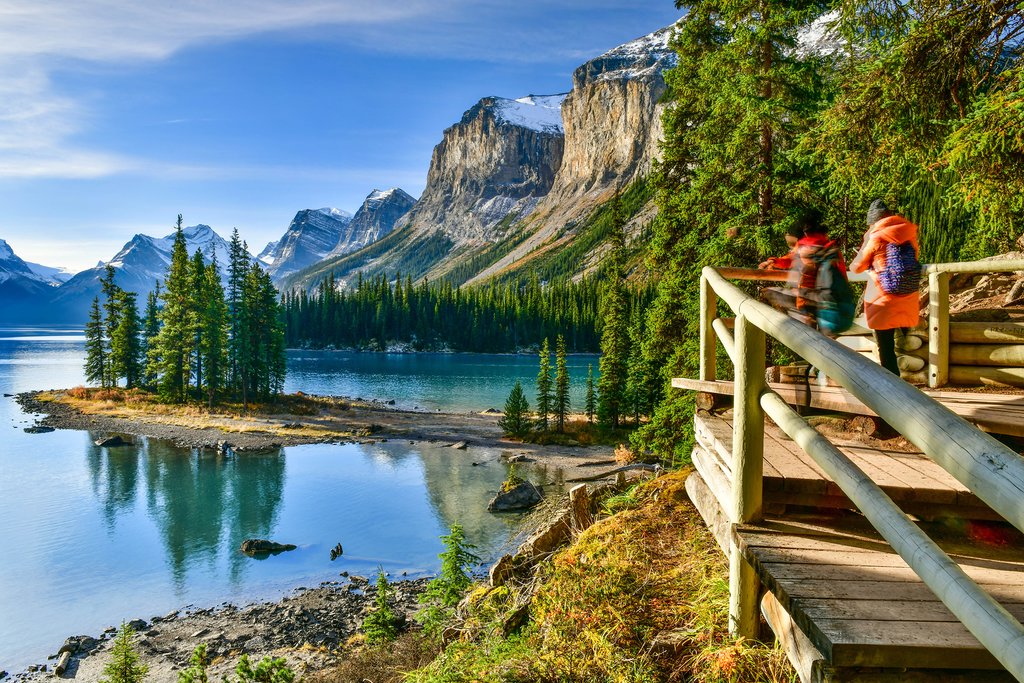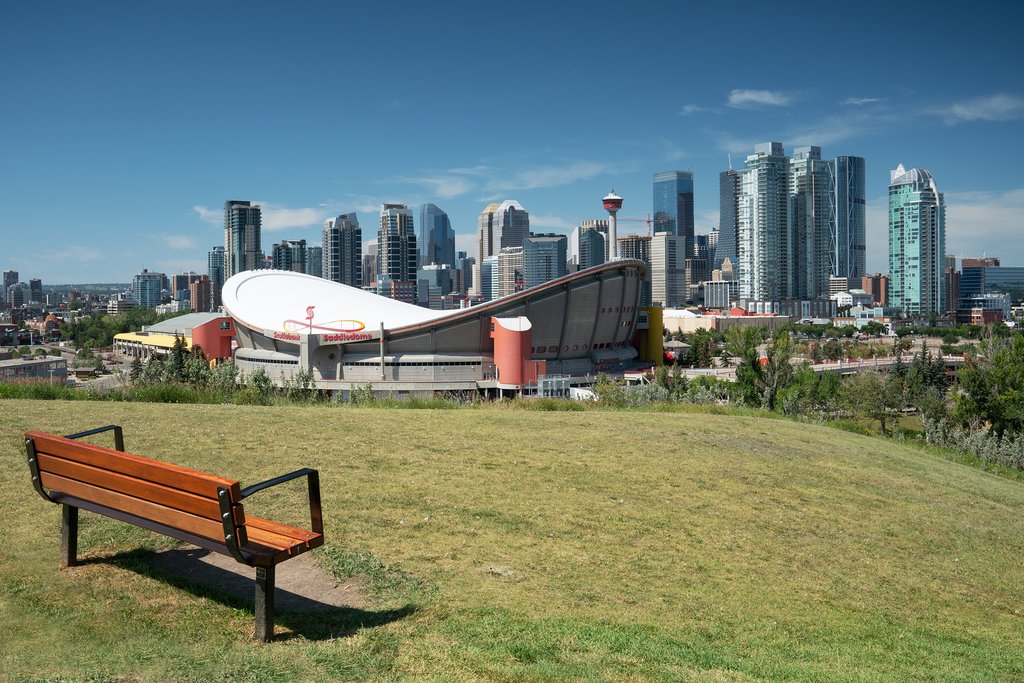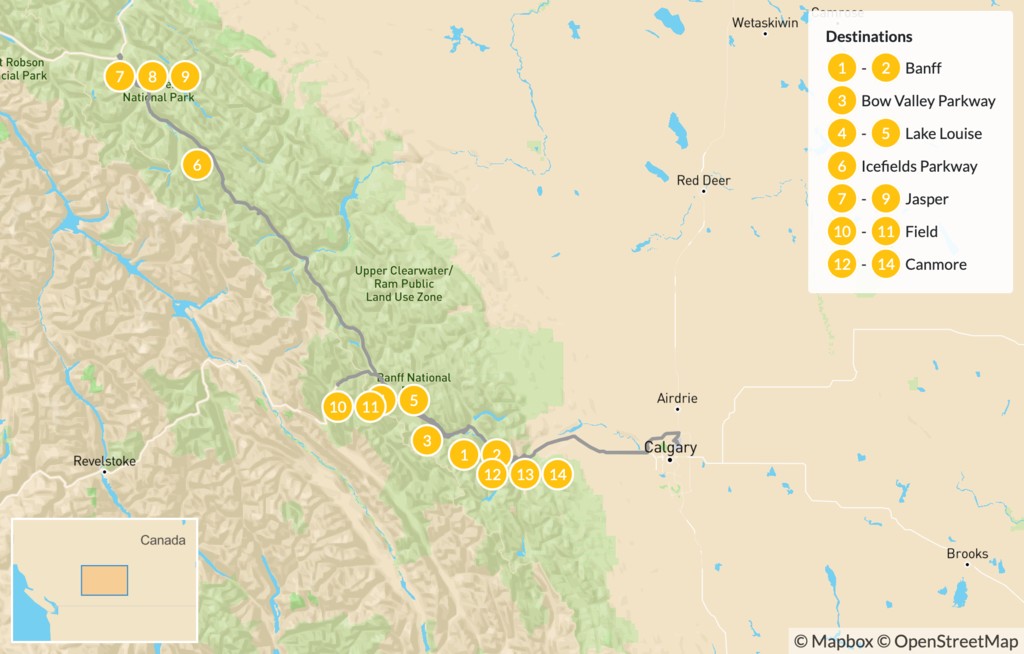Highlights
- Drive the Icefields Parkway in both directions, taking in all the highlights
- Multiple overnights in the best locations for accessing the backcountry trails
- Hike through Kananaskis Country, the hidden gem of the Canadian Rockies
- Experience the Canadian Rockies in a more unique way that avoids the crowds
Brief Itinerary
| Day | Highlights | Overnight |
|---|---|---|
| Day 1 | Arrive in Calgary, Drive to Banff (2 hours) | Banff |
| Day 2 | Explore around Banff | Banff |
| Day 3 | Banff to Bow Valley Parkway (45 min) | Bow Valley Parkway |
| Day 4 | Bow Valley Parkway to Lake Louise (30 min) | Lake Louise |
| Day 5 | Day Hikes around Lake Louise | Lake Louise |
| Day 6 | Lake Louise to Icefields Parkway (2 h 30 min) | Icefields Parkway |
| Day 7 | Icefields Parkway to Jasper (45 min) | Jasper |
| Day 8-9 | Explore Jasper National Park | Jasper |
| Day 10 | Jasper to Yoho National Park (3 h 30 min) | Field |
| Day 11 | Explore Yoho National Park | Field |
| Day 12 | Yoho National Park to Canmore (1 h 15 min) | Canmore |
| Day 13 | Explore around Canmore | Canmore |
| Day 14 | Canmore to Calgary, Depart (1 h 30 min) |
Detailed Itinerary
Day 1: Arrive in Calgary, Drive to Banff (2 hours)

Welcome to Calgary, the gateway to the Canadian Rockies! Instead of staying in Calgary, grab any supplies you need and follow the Trans Canada Highway (Highway 1) west toward Banff, a popular base camp for exploring Banff National Park. En route, stop in Canmore for a quick meal and a short stroll. Check out the eclectic PD3 by Blake restaurant where they serve Asian-inspired cuisine from a remodeled 1962 silver double-decker bus.
Banff, a small mountain town located within Banff National Park (Canada's first national park), is one of Canada's most visited destinations and can become quite busy during summer months. You'll find year-round opportunities for outdoor adventures and can access most of the park's iconic sites on a day trip.
Check out the Banff Park Museum for an introduction to the park and its local wildlife. There's also the Banff Gondola which takes you to the top of Sulphur Mountain for a walk along the boardwalk trail (or skip the gondola and hike up for free). From the summit, you'll have great views of the nearby mountains and can also grab dinner at Sky Bistro. Take an evening dip in the hot mineral waters of the Upper Hot Springs Pool (closes 10 pm) before signing off for the night.
Driving time (Calgary International Airport to Banff): 2 hours (79 miles / 127 km)
Day 2: Explore around Banff

Before the crowds arrive, find your way to the Cave and Basin National Historic Site to understand how the popular park got its start. Walk through a dimly lit rock-lined tunnel to see the grotto discovered in 1883 that lead to Banffs national park designation and then enjoy a morning hike choosing from one of the hundreds of options available. Pick up park maps and hiking tips (and bear spray) from the Banff Visitor Center.
For a challenge, arrange a guided climb (three hours) on the Mount Norquay Via Ferrata (Italian for 'iron way') following a protected climbing route as you clip into a series of fixed iron cables. An easier option (and one of the best hikes from the town center) is to take the Bow River and Hoodoos trails. Starting at Gopher Street, hike past the Bow Falls and Surprise Corner to the hoodoos, odd-looking limestone rock spires (6.3 miles / 10.2 km roundtrip).
To satisfy your post-hiking appetite, head to Bear Street Tavern and then take to the water on a one-hour cruise of Lake Minnewanka. If you have the energy to spare, consider renting a canoe or kayak instead. Toward dusk, look for wildlife—beavers, elk, ospreys, and bald eagles—along the shores of tranquil Vermilion Lakes followed by pre-dinner drinks and Mediterrasian tapas at Block Kitchen & Bar. Then hang out with real live cowboys as you two-step the night away at Wild Bill's Legendary Saloon.
Day 3: Banff to Bow Valley Parkway (45 min)

Just east of Banff, the Bow Valley Parkway branches off of the Trans Canada Highway and is an alternate (less-crowded) route for getting to Lake Louise. This 30-mile (50 km) stretch of road is a mini-version of the Icefields Parkway and is one of the best places in the Canadian Rockies to spot wildlife (so much so that a section of the road closes each night to allow wildlife to cross safely).
Hit the road early in the morning for the best chances of spotting wildlife and before the traffic builds up throughout the day (it's also beautiful in the morning as the sun lights up the waterfalls en route). You can easily spend a day exploring this section of road, checking out places like Johnston Canyon, Morant’s Curve, and Castle Junction (as well as a number of great hiking trails in the area).
Note: From March 1 to June 25, the road is closed between 8 pm and 8 am on the 17-kilometer section of the parkway between Johnston Canyon Campground to the Fireside Picnic Area to ensure that bear, wolves, deer, and other wildlife can cross safely.
Driving time (Banff to Bow Valley Parkway): 45 minutes (16 miles / 25 km)
Day 4: Bow Valley Parkway to Lake Louise (30 min)

Follow the remaining stretch of the Bow Valley Parkway to Lake Louise, one of the most popular destinations in the Canadian Rockies and a great base camp for exploring the mountains. (Keep in mind, Lake Louise and Lake Louise Village are two separate places a short distance apart. In the summer, Lake Louise becomes incredibly busy with travelers, although very few people venture far beyond the lake. Meaning you can escape the vast majority of the crowds by simply taking a short hike!
Note: Due to limited parking at Lake Louise and Moraine Lake lakeshores in the summer, you must book your spot on a shuttle in advance.
Driving time (Bow Valley Parkway to Lake Louise): 30 minutes (22 miles / 35 km)
Day 5: Day Hikes around Lake Louise

The day is yours to explore by foot around Lake Louise and Moraine Lake. There are numerous amazing routes that get you away from the crowds and up into the beautiful alpine of the Canadian Rockies. All of the hikes are well marked and regularly maintained. You'll find map boards with trail descriptions at both Lake Louise and Moraine Lake right near the shoreline. Still, don't hesitate to visit the visitor center beforehand or purchase a backcountry map, just to be safe. The intensely blue Lake Moraine gets very crowded during the day, so best to visit very early in the morning and then visit Lake Louise afterward.
Chat with a local specialist who can help organize your trip.
Day 6: Lake Louise to Icefields Parkway (2 h 30 min)

Lake Louise marks the southern extremity of the Icefields Parkway (Highway 93 N), the iconic stretch of road that connects Lake Louise and Jasper and embodies what many consider to be the heart of the Canadian Rockies. You'll pass by monumental glaciers, turquoise lakes, enormous mountains and stretches of road that leave you eager to discover what's behind every curve. Most travelers only budget a day for the Icefields Parkway, but you'll be spending two days to explore and appreciate all the views this section of highway has to offer.
Driving time (Lake Louise to Icefields Parkway): 30 minutes (112 miles / 180 km)
Day 7: Icefields Parkway to Jasper (45 min)

Complete the final stretch of the Icefields Parkway as you head to Jasper. Again, get an early start so you have ample time to make stops along the way. You will likely arrive in Jasper in the early afternoon. This alpine town is situated in the heart of Jasper National Park, set against a backdrop of beautiful mountains. It’s small enough to explore on foot and has a decent selection of restaurants, bars, and shops. It’s mainly used, however, as a gateway for enjoying the nearby outdoor activities—from hiking, canoeing and rafting along the Athabasca River, to simply enjoying the numerous viewpoints accessible by car.
Just southwest of town is the Jasper SkyTram, which will take you to Whistlers Peak (8,100 ft. / 2,500 m). The views from here stretch for miles, giving you a great feel for the town, lakes, and the entirety of Jasper National Park. Aim to go near sunset at the last ride up the mountain.
Driving time (Icefields Parkway to Jasper): 30 minutes (34 miles / 55 km)
Day 8-9: Explore Jasper National Park

Spend the day exploring Jasper National Park. Twice as vast as its southern neighbor, Banff National Park, this is the largest national park in the Canadian Rockies and home to countless lakes, hiking trails, and a variety of wildlife. Many of the park's main highlights are located within the Maligne Valley, a 15-minute drive northwest of town. Get there early (before 8 am) to beat the crowds, stopping first for a short walk to Maligne Canyon, a 160 ft (50 m) deep gorge carved out by the river over the course of 10,000 years. From there, you can rent a canoe or take a guided cruise on Maligne Lake just before midday before heading back to Jasper.
Other popular highlights the hike to Mount Edith Cavell and the cable car that takes you up Whistlers Mountain for panoramic views of the valley and the surrounding mountains. Keep an eye out for the park's wildlife at all times, as you're likely to see sheep and mountain goats along the valley trails.
You can also check out Miette Hotsprings (a 45-minute drive northwest of Jasper) on the same day depending on how much driving you're willing to do (or save it for another day).
Day 10: Jasper to Yoho National Park (3 h 30 min)

Follow the Icefields Parkway south toward Lake Louise. Start your drive early so you have time to stop at the numerous lakes and glaciers along the way, given this is one of the most beautiful stretches of highway in the Canadian Rockies. Just before reaching Lake Louise, head west on the Trans-Canada Highway to the town of Field. You've now entered the beautiful Yoho National Park!
Driving time (Jasper to Field): 3 hours, 30 minutes (155 miles / 250 km)
Day 11: Explore Yoho National Park

Start the day early to cover Yoho's highlights as well as to avoid the throngs of travelers. Drive to Emerald Lake and allow 90 minutes to walk the 3-mile (5.2-km) Emerald Lake Loop. You'll have views of the jewel-hued waters encircled by spruce and firs and the snow-capped Rockies, including the iconic profile of Mount Burgess. Make sure to check out Natural Bridge on your way in or out.
Meanwhile, if it's serious hiking you're after, choose from one or two of over 250 miles (400 km) worth of trails. One of the best hikes in the Rockies is the Iceline Trail, a challenging 13-mile (21-km) roundtrip. It will take you the better part of the day (typically eight hours), but the views alone will supply you the fuel to keep going.
Then there's the wealth of trails that radiate out from picturesque Lake O'Hara with the longest only 4.7 miles (7.5 km). Take the 2-mile (3.2 km) Lake Oesa Trail to climb an elevation of 787 feet (240 m) to overlook the lake. If you're experienced, opt for one of five Alpine routes for a bit of everything: alpine meadows, glaciers, and wooded hillsides.
Note: Private vehicles are not permitted on the Lake O'Hara road. You must either reserve a spot on the Park's Canada shuttle bus (spots fill up months in advance) or walk to the lake (7 miles /11 km).
Day 12: Yoho National Park to Canmore (1 h 15 min)

Leaving Field, it's just over an hour's drive to Canmore through some more of the spectacular scenery of the Canadian Rockies. Canmore used to be a mining town but has seen significant growth as a back-up location to the busier (and more touristy) town of Banff. Depending on who you ask, Canmore and its surroundings are arguably more beautiful and you'll be closer to Calgary for your onward journey.
Driving time (Field to Canmore): 1 hour, 15 minutes (62 miles / 100 km)
Day 13: Explore around Canmore

Located just outside of Banff National Park, Canmore, like everywhere in the Canadian Rockies, is surrounded by incredible scenery and serves as a great base for exploring the outdoors—but without as many crowds as Banff. Downtown, you'll find souvenir shops, galleries, breweries, outdoor stores and a number of great restaurants. There's also a Mountain Market held every Thursday in summer where you can pick up local produce and artisan products.
To explore the area, consider renting a bike and cycling the mostly flat Legacy Trail (16 miles / 26 km) between Canmore and Banff for breathtaking views of the Three Sisters and Vermillion Lakes. (Returning from Banff, you can take the Roam transit bus if you don't want to cycle back.)
Canmore is also the closest town for heading off into Kananaskis Country, a park system encompassing the eastern foothills of the Canadian Rockies—a hidden, lesser-known gem containing numerous beautiful hikes and vantage points but without the crowds of the national park.
As far as options go, Ha Ling Peak is a popular hike that takes around 2-3 hours to get up and one hour to get back down. For a longer hike, check out Rawson Lake and Sarrail Ridge, a moderate 7-mile (11 km) hike near the eastern tip of Upper Kananaskis Lake (around 5 hours return). If you're keen to see wildlife, head to Engadine Lodge and Moose Meadows (a one-hour drive down the Spray Lakes/Smith Dorien trail from Canmore). It's a nice spot for an afternoon tea surrounded by beautiful meadows which are one fo the best spots in the Canadian Rockies to spot wildlife.
You can also check out the Yamnuska Wolfdog Sanctuary, a non-profit organization that rehabilitates and houses wolfdogs (part wolf, part dog) from all over North America. They run educational tours that take you through their habitat and raise awareness about this type of breed.
Day 14: Canmore to Calgary, Depart (1 h 30 min)

From Canmore, it's a short drive to Calgary's international airport. Be sure to leave ample time in case of traffic and to drop off your rental vehicle. En route look for signage leading you to the airport.
Driving time (Canmore to Calgary International Airport): 1 hour, 30 minutes (75 miles / 120 km)


